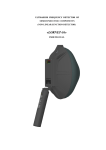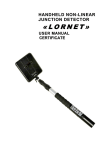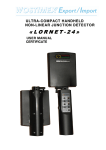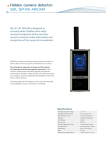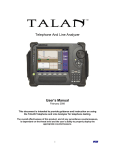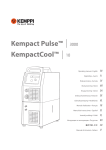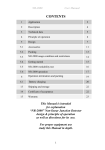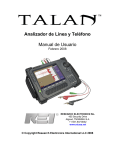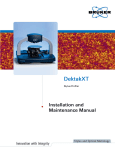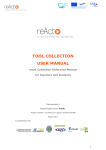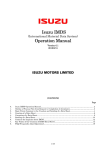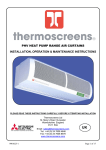Download Lornet-0836. User manual. Version December, 2014. - TS
Transcript
«LORNET-0836» Double Probing Frequency Non-Linear Junction Detector TECHNICAL DESCRIPTION & OPERATION MANUAL CERTIFICATE © TS-Market Contents Technical Description.............................. 3 1. Introduction................................................... 3 2. Technical Parameters................................... 5 3. Delivery Set and Accessories..................... 8 4. Purpose of the Detector Basic Units........ 10 5. Safety Measures......................................... 15 6. Operation Order.......................................... 16 7. Search Recommendation.......................... 19 CERTIFICATE.......................................... 20 1. General........................................................ 20 2. Delivery set................................................. 21 3. Warranty...................................................... 22 4. Acceptance Certificate............................... 22 5. Package Certificate.................................... 23 6. Claims Data................................................. 24 Technical Description 1. Introduction The double probing frequency non-linear junction detector «LORNET-0836» (further NLJD) is used to for search and location of electronic devices both in active and switch-off state. The detector operation is based on the property of semiconductor components to generate a response at the 2nd and 3rd harmonics when radiated by an UHF probing signal. Semiconductor components of artificial origin will have a higher level second harmonic while semiconductor components of natural origin (e.g. oxide films) will have a higher level third harmonic respectively. The NLJD analyzes the 2nd and 3rd harmonics response of the radiated objects, which enables a quick and reliable identification of electronic devices and natural oxide semiconductors. The unique feature of the device in comparison with analogues is that it combines two detectors at different frequencies. The frequency of one transmitter is 790 MHz, and the other is 3600 MHz. Therefore the device has undeniable advantage over single-frequency devices due to: • it is better to detect small-sized and highfrequency semiconductor devices at high frequency (and vice versa); • it is better to work in wet ground and concrete walls at low frequency; • two antennas with wide (at low frequency) and narrow (at high frequency) direction diagrams enable to evaluate the situation first (at low frequency) and then to detect an object precisely using high frequency. The NLJD automatically finds the best receiving frequency channel free of noise and distortion providing flawless operation in the complicated electromagnetic environment. An embedded parabolic antenna with high gain (20 dB at 3600 MHz) enables high precise detection of semiconductor components in space. To make operator’s work easier the NLJD is equipped with a laser pinpointing a place where an antenna is directed. There are two types of radiated signals: • pulse modulated carrier with a duty cycle of 0.4 % (Pulse). • pulse modulated carrier with a duty cycle of 6.0 % (CW). CW mode is used to listen to the envelope detector output as well as to the received signal level via a built-in loudspeaker and wireless head phones to detect working analog radio microphones due to acoustic bonding. Output power automatic control mode significantly simplifies operator’s work. The NLJD simultaneously displays the 2nd and 3rd harmonics levels at its LED panel. An operator can make search at both frequencies simultaneously or at one (high or low) frequency. In case doublefrequency operation mode is chosen the indicators display the signal level of the receiver which is higher at the moment. Besides, the 2nd and 3rd harmonics levels can be estimated in turn aurally by click repetition rate reproduced through a built-in loudspeaker or wireless earphones. 2. Technical Parameters. 2.1. Types of radiated signals: • pulse modulated carrier with a duty cycle of 0.4 % (Pulse). • pulse modulated carrier with a duty cycle of 6.0 % (CW). • Pulse width - 12 μs, pulse repetition rate – 300 Hz or 5 kHz. 2.2. Receiver and transmitter carriers are given in Table 1. Carrier frequency (one of three) is chosen by minimum path interference of the corresponding 2nd harmonic receiver automatically. Table 1 3581.5 3594.5 3607.5 1583 7163 7189 7215 2374.5 10744.5 10783.5 10822.5 791.5 1581 3rd harmonic receiver, MHz 2371.5 790.5 2nd harmonic receiver, MHz 1579 Upper range 2368.5 Transmitter, MHz Lower range 789.5 Frequency 2.3. Maximum power with duty cycle of 0.4% (Pulse) • not less 25 W in lower range. • not less in 18 W in upper range. 2.4. Maximum power with duty cycle of 6.0 % (CW) – not less 6 W in both ranges. 2.5. Automatic or manual power control. Power control range – 20 dB from maximum value, divided into 11 level gradations. 2.6. Transmittance antenna gain of upper range – not less 20 dB, beam width by -3 dB level – 22 degrees. 2.7. Transmittance antenna gain of lower range – not less 6 dB, beam width by -3 dB level – 60 degrees. 2.8. Receiver antenna gain of upper range – not less 24 dB, of lower range – not less 8 dB. 2.9. Receivers sensitivity better than –110 dBm (one LED lights up at the indicator scale). 2.10. Receiving path dynamic range – 30 dB (20 dB – LED indicator range, 10 dB – attenuator range at receivers input adjusting by ATT button). 2.11. Time of continuous operation with a lithiumIon battery at the maximum radiated power: • ≥2.5 hours in the pulse mode; • ≥1.5 hours in the CW mode. 2.12. Weight of receiver-transmitter unit – not more 1 kg. 2.13. Operating conditions: • ambient temperature 5…40C. • pressure 450mm of mercury 3. Delivery Set and Accessories. 3.1. The device includes units and accessories stated in the Table 2 below: Table 2 No. Name 1 Receiver-transmitter unit with control unit and built-in battery container 2 Changeable Li-Ion batteries 3 Container for battery charging 4 Charger for receiver-transmitter unit (CH1) 5 Wireless phones including: receiving device, earphones and charger (CH2) 6 Technical Description & User manual, Certificate (in one piece) 7 Package Q-ty 1 2 1 1 1 1 1 2 3 6 7 4 5 Fig. 1 Appearance of NLJD is given in Fig 1, where: 1-receiver-transmitter unit 2-LED indicators 3-control panel 4-power switch 5-screwed up cover of battery section 6-container for battery charging 7-charger for receiver-transmitter unit (CH 1) Fig. 2 Fig. 2 shows a receiver for wireless phones, its charger (CH 2) and head phones. 4. Purpose of the Detector Basic Units 4.1. A receiver-transmitter unit is used for: • Analysis of distortion and interference in the instrument receiving path, which is made each time the transmitter is switched on. Therefore, if an interfering signal appears during operation (in a complicated electromagnetic environment) it is necessary to turn the detector transmitter off and on from time to time thus selecting an optimal frequency automatically, providing the best sensitivity and detection range of semiconductor components. • Generation UHF signal, reception and digital processing of the 2nd and the 3rd frequency harmonics. Simultaneous display of the 2nd and the 3rd harmonics levels gives the opportunity to distinguish with a high reliability between signals of artificial semiconductors integrated in electronic devices and natural corrosive ones which appear at oxidation of connecting points of various metals. 10 • Demodulation of the 2nd harmonic response for listening via earphones or a built-in loudspeaker. An operator can control sound volume. An operator can listen to demodulated signals of the 2nd harmonic from lower or upper receiver ranges in turn. • Indication of the receiver power level and levels of the 2nd and 3rd harmonics of the signals received. 4.2. The control panel is used to control operation of the detector. It is placed on the arm into which a battery is embedded. Control board, buttons for operation modes control and display LEDs are placed in the case. Control panel and its buttons functions are given in Fig.3. Functions of control panel indicators: Continuous lighting of any indicator corresponds to «ON» position, absence of lighting – to «OFF» position. Simultaneous flickering of all control panel indicators shows a built-in battery is discharged and needs to be charged. 11 2nd harmonic level Transmitter (s) power 1. Turn on transmitter (s) of lower, upper or both frequency ranges 3rd harmonic level 9,10 – volume control buttons 2. Turn on listening to phones or loud-speaker 7,8 – transmitter(s) power control buttons 3. Turn on Pulse or CW mode 6 Receivers attenuator control 4. Power switch Indicator for receiver attenuator 5 Turn on transmitter (s) Fig.3 12 4.3. Battery charging of the receiver-transmitter unit is to be made with a battery charger included to the delivery set only. Using other chargers is not allowed. For charging it is necessary to remove a battery unscrewing a cover at the edge of the arm and place it into a charger (CH 1). While a charger is connecting to the power mains a red LED is lightning at its case. When a battery is completely charged, the red LED goes out, and a green LED lights up. Charging time of a fully discharged battery does not exceed 5 hours. 4.4. Wireless telephones consist of a receiving device, earphones and charger CH2 (Fig.2). Appearance of the receiving device and position of control units are shown in Fig.4. 13 Socket for phones connection Socket for charger connection Power indicator (lights up when ON) Charging indicator (lights during charging) Volume control Slide-type switch Fig.4 Receiving Device 14 4.5 Receiving device operation order: • Using charger combined with mains plug CH2 included to the delivery set charge a built-in battery completely, here CHARGE indicator goes out. • Connect head phones to a corresponding socket. • Turn the receiving device on by a slide-type switch, here POWER LED lights up. • Using volume control set a comfortable volume level. • If the receiving device is turned on when the detector is off, then there is only a noise signal in the head phones at higher volume. After turning on acoustic indicator signals corresponding to the operating mode of the detector appear in the earphones. 5. Safety Measures 5.1. By requirements of electric safety the detector corresponds to protection class 1. 5.2. The instrument is to be operated only by persons who have been duly instructed for safety measures while working with electric and measuring devices with open RF energy radiators. 5.3. An operator is not recommended to direct an antenna to people or to be himself towards radiation maximum. 15 6. Operation Order 6.1. Remove the detector from the package. After device transportation at negative temperatures it is necessary to keep the device in the switch-off state at room temperature at least for 30 minutes. 6.2. Turn the detector on by the type-slide switch 4 (Fig.3) placed on the arm. Two indicators RF1 and a loudspeaker LED will light up. One yellow LED should light on the circle scale of the probing signal power indicator. Its initial position corresponds to the maximum power of the probing signal. The probing signal transmitter is off (it is turned on after pressing PWR button 5 only). The 2nd and 3rd harmonics indicators should not light. 6.3. Turn on the probing signal transmitter pressing PWR button 5. By default RF1 transmitter of the lower frequency range, PULSE (duty cycle 0.4%) transmitter mode and AUTO automatic power control are turned on. The power of a radiated signal will change depending on a signal level at the 2nd harmonic receiver output. In this mode acoustic information of the 2nd harmonic response is applied to the loudspeaker or head phones. To switch over to the manual mode of the probing signal power control (MNL indicator lights up) press one of output power control buttons after the 16 probing signal transmitter has been turned on. Turn the probing signal transmitter off and then turn it on for a reverse switch over using PWR button. During operation in premises with a lot of electronic devices it is recommended to work at lower power of the probing signal. The optimum probing signal level is determined by experimental way. 6.4. Before pressing PWR button 5 one can turn the upper range transmitter on by button 1 (Fig.3). Also, one can press this button while the lower range transmitter is on, here RF2 LED lights up. If button 1 is pressed again, both transmitter are turned on, so both RF1 and RF2 LEDs light up. Further pressing this button will turn the lower range transmitter on again and so on. 6.5. If button 3 is pressed when one of the transmitters is on, then the transmitter is switched over to CW mode with duty cycle of 6.0 % and frequency repetition rate of 5 kHz. In this mode a received signal from the 2nd harmonic receiver output passes via low-frequency filter with cutoff frequency of 3 kHz and is applied to the built-in loudspeaker and wireless phones. The given mode can be used for search of analog radio microphones. In this case acoustic bonding must appear when listening to the built-in loudspeaker. 17 There can be places with unstable electric contact between metallic objects with corrosion in a room under detecting, which can generate false response by the 2nd harmonic. In this case one can knock strongly in the place of the supposed position, here a crack must appear in the loudspeaker (earphones). 6.6. Simultaneous flickering of all indicators on the control panel indicates that the battery is discharged. Turn the detector power off, unscrew a cover at the edge of the arm, remove a battery, place it into a container and charge it using charger CH1. 6.7. If a response signal is to be listened via phones press the corresponding button 2 (Fig.3) and turn a receiving device on (cl.4.4). Attention: 1) Do not direct the antenna towards the operator and people nearby. 2) While operating the device constantly monitor battery state charging it in-time (by the indicators signal). The detector must be kept with a battery charged. 3) Charging should be done with a charger included into the delivery set only, using of unauthorized chargers are strongly prohibited. 18 7. Search Recommendation 7.1. If possible remove electronic devices from the room examined. If it is impossible, examination should be done at a decreased radiated power. 7.2. Set maximum radiated power level and one of the operation modes of the receiver. 7.3. Direct the antenna to the surface under examination using a laser beam spot. Analyze behavior of the received signal of the 2nd and 3rd harmonics moving a laser beam spot over the surface under examination smoothly and changing the antenna orientation by an indicator visually. 7.4. Analysis of the received 2nd and 3rd harmonics levels is made both by number of LEDs lightning on the corresponding indicator scale and by clicks repetition rate in the loudspeaker or phones. 7.5. Remove the antenna unit from the surface examined or decrease output power and repeat measurements of the received signal level. For more accurate location as well as for protection of receiving devices from overload it is possible to decrease receivers sensitivity using ATT button. 7.6. When an artificial р-n transition is found you will normally see stable lightning of the 2nd harmonic indicator LEDs. While rapping at the suspected place of a p-n transition, readings of LEDs do not change. 19 7.7. When a natural р-n transition is found, you will observe stable lightning of the 3rd harmonic indicator LEDs. While rapping at the examined surface intensively, readings of indicators by the 3rd harmonic will change, as a rule. The search technique offered does not reflect all nuances which may appear in each exact case, and represents a recommendation only 1. General CERTIFICATE 1.1. Before operation study User Manual for «LORNET-0836» thoroughly. 1.2. The Certificate is included in the delivery set and should be always kept with the instrument. 1.3. If the device is sent for repair or to a different place during operation the Certificate is to be shipped with the instrument. 1.4. Marks in the Certificate should be done intime. 1.5. All records in the Certificate should be made by ink only, distinctly and carefully. All unauthorized erasures, blots and corrections are not permissible. 1.6. It is forbidden to make any notes or records in the fields and on the cover of the Certificate. 20 2. Delivery set No 1 2 3 4 5 6 7 Name Q-ty Receiver-transmitter unit with control unit and builtin battery container Changeable Li-Ion batteries Container for battery charging Charger for receivertransmitter unit (CH1) Wireless phones including: receiving device, earphones and charger (CH2) Technical Description & User manual, Certificate (in one piece) Package 21 1 2 1 1 1 1 Serial No 3. Warranty 3.1. Warranty period for «LORNET-0836» is 12 months upon supply to the customer. 3.2. Life time is 6 years. 3.3. If the device fails during warranty period provided the customer has followed all the operation, transportation and storage rules, the manufacturer is to make the repair free of charge or replace the device. 3.4. Warranty does not cover power elements. 4. Acceptance Certificate A CCEPTANCE CERT I F I C AT E Non-Linear Junction Detector «LORNET-0836» name No ________ serial number is manufactured and accepted according to obligatory requirements of state standards, current technical documentation and is fit for service. Technical inspection _________ signature stamp __________ name 22 _____________ date, month, year 5. Package Certificate PACKAGE CERT I F I C AT E Non-Linear Junction Detector «LORNET-0836» name No ________ serial number Packaged by: ELVIRA Production Co., Ltd. according to the requirements stated in the given technical documentation. ____ title _______ signature _________ name 23 _____________ date, month, year 6. Claims Data In case of a package damage during transportation claims are applied to the transportation organization according to the respective regulations. If the delivery set is not complete or the NLJD is damaged, provided that its package is not damaged, an Act is made together with a representative of the manufacturer. If a defect appears during the warranty period, the customer is to send the NLJD to the manufacturer with an accompanying letter, stating the reason of the claim. All claims with a brief description of encountered problems and measures taken are recorded in Table 3. Table 3 Claim content Reason, measures taken 24


























